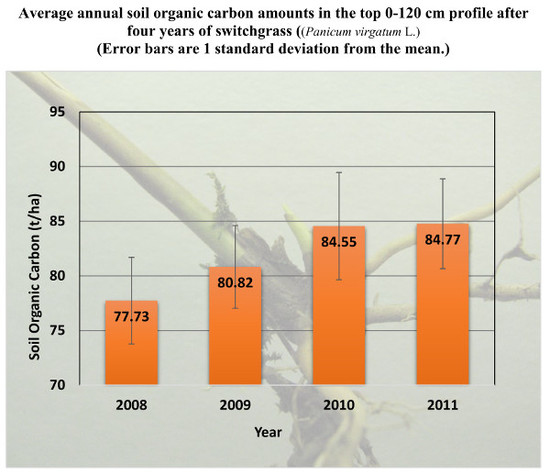Soil Organic Carbon Changes for Switchgrass Farms in East Tennessee, USA
Abstract
:1. Introduction
2. Materials and Methods
2.1. Site
2.2. Soil Sampling and Analysis
- Each soil type was assigned a number of sampling points based on its size within the farm.
- ○
- If the area was less than 0.81 hectares then no points were assigned,
- ○
- if the area was between 0.81 and 4.05 hectares the algorithm assigned 4 points, and
- ○
- if the area was greater than 4.05 hectares the number of points assigned was one point per hectare.
- Each point was placed randomly but was guaranteed not to fall within 7.62 m from the soil boundaries and guaranteed to be at least 30.5 m from every other point.
3. Results and Discussion
3.1. ANOVA Analysis
3.2. Regression Analysis
4. Conclusions
Author Contributions
Acknowledgments
Data Availability
Conflicts of Interest
References
- Clark, C.M.; Lin, Y.; Bierwagen, B.G.; Eaton, L.M.; Langholtz, M.H.; Morefield, P.E.; Ridley, C.E.; Vimmerstedt, L.; Peterson, S.; Bush, B.W. Growing a Sustainable Biofuels Industry: Economics, Environmental Consideration, and the Role of the Conservation Reserve Program. Environ. Res. Lett. 2013, 8, 1–19. [Google Scholar] [CrossRef]
- United States Environmental Protection Agency, Renewable Fuel Standard (RFS). Available online: http://www.epa.gov/otaq/fuels/renewablefuels/index.htm (accessed on 28 April 2014).
- Jensen, K.; Clark, C.D.; Ellis, P.; English, B.C.; Menard, R.J.; Walsh, M.; de la Torre Ugarte, D. Farmer’s Willingness to Grow Switchgrass for Energy Production. Biomass Bioenergy 2007, 31, 773–781. [Google Scholar] [CrossRef]
- Bransby, D. Switchgrass Profile. Available online: http://bioenergy.ornl.gov/papers/misc/switchgrass-profile.html (accessed on 10 September 2010).
- McLaughlin, S.; Bouton, J.; Bransby, D.; Conger, B.; Ocumpaugh, W.; Parrish, D.; Taliaferro, C.; Vogel, K.; Wullschleger, S. Developing Switchgrass as a Bioenergy Crop. In Perspective on New Crops and New Uses; Janick, J., Ed.; ASHS Press: Alexandria, VA, USA, 1999. [Google Scholar]
- Mooney, D.F.; Roberts, R.K.; English, B.C.; Tyler, D.D.; Larson, J.A. Yield and Breakeven Price of ‘Alamo’ Switchgrass for Biofuels in Tennessee. Agron. J. 2009, 101, 1234–1242. [Google Scholar] [CrossRef]
- Lemus, R.; Brummer, E.C.; Moore, K.J.; Molstad, N.E.; Burras, C.L.; Barker, M.F. Biomass Yield and Quality of 20 Switchgrass Populations in Southern Iowa, USA. Biomass Bioenergy 2002, 23, 433–442. [Google Scholar] [CrossRef]
- Shahandeh, H.; Chou, C.Y.; Hons, F.M.; Hussey, M.A. Nutrient Partitioning, Carbon and Nitrogen Mineralization of Switchgrass Plant Parts. Commun. Soil Sci. Plant Anal. 2011, 42, 599–615. [Google Scholar] [CrossRef]
- Garten, C.T., Jr.; Smith, J.L.; Tyler, D.D.; Amonette, J.E.; Bailey, V.L.; Brice, D.J.; Castro, H.F.; Graham, R.L.; Gunderson, C.A.; Izaurraide, R.C.; et al. Intra-Annual Changes in Biomass, Carbon, and Nitrogen Dynamics at 4-Year Old Switchgrass Field Trials in West Tennessee, USA. Agric. Ecosyst. Environ. 2010, 136, 177–184. [Google Scholar] [CrossRef]
- Bransby, D.I.; McLaughlin, S.B.; Parrish, D.J. A Review of Carbon and Nitrogen Balances in Switchgrass Grown for Energy. Biomass Bioenergy 1998, 14, 379–384. [Google Scholar] [CrossRef]
- Al-Kaisi, M.M.; Yin, X.; Licht, M. Soil Carbon and Nitrogen Changes as Influenced by Tillage and Cropping Systems in some Iowa Soils. Agric. Ecosyst. Environ. 2005, 105, 635–647. [Google Scholar] [CrossRef]
- Lee, D.K.; Owens, V.N.; Doolittle, J.J. Switchgrass and Soil Carbon Sequestration Response to Ammonium Nitrate, Manure, and Harvest Frequency on Conservation Reserve Program Land. Agron. J. 2007, 99, 462–468. [Google Scholar] [CrossRef]
- Ma, Z.; Wood, C.W.; Bransby, D.I. Soil Management Impacts on Soil Carbon Sequestration by Switchgrass. Biomass Bioenergy 2000, 18, 469–477. [Google Scholar] [CrossRef]
- Anderson-Teixeira, K.J.; Davis, S.C.; Masters, M.M.; Delucia, E.H. Changes in Soil Organic Carbon under Biofuel Crops. GCB Bioenergy 2009, 1, 75–96. [Google Scholar] [CrossRef]
- Zan, C.S.; Fyles, J.W.; Girouard, P.; Samson, R.A. Carbon Sequestration in Perennial Bioenergy, Annual Corn and Uncultivated Systems in Southern Quebec. Agric. Ecosyst. Environ. 2001, 86, 135–144. [Google Scholar] [CrossRef]
- Epstein, H.E.; Laurenroth, W.K.; Burke, I.C. Effects of Temperature and Soil Texture on ANPP in the US Great Plains. Ecology 1997, 78, 2628–2631. [Google Scholar] [CrossRef]
- Jobbagy, E.G.; Jackson, R.B. Global Controls of Forest Line Elevation in the Northern and Southern Hemispheres. Glob. Ecol. Biogeol. 2000, 9, 253–268. [Google Scholar] [CrossRef]
- Sorenson, L.H. Carbon-Nitrogen Relationships during the Humification of Cellulose in Soils Containing Different Amounts of Clay. Soil Biol. Biochem. 1981, 13, 313–321. [Google Scholar] [CrossRef]
- Jung, J.Y.; Lal, R. Impacts of Nitrogen Fertilization on Biomass Production of Switchgrass and Changes in Soil Organic Carbon in Ohio. Geoderma 2011, 166, 145–152. [Google Scholar] [CrossRef]
- Liebig, M.A.; Johnson, H.A.; Hanson, J.D.; Frank, A.B. Soil Carbon under Switchgrass Stands and Cultivated Cropland. Biomass Bioenergy 2005, 28, 347–354. [Google Scholar] [CrossRef]
- United States Department of Agriculture, Natural Resource Conservation Service. Soil Survey Geographic Database (SSURGO). Available online: http://www.nrcs.usda.gov/wps/portal/nrcs/detail/soils/survey/?cid=nrcs142p2_053627 (accessed on 10 February 2012).
- Microsoft Visual Basic. Available online: http://msdn.microsoft.com/en-us/vbasic/default.aspx (accessed on 4 September 2010).
- ESRI, ArcGIS. Available online: http://www.esri.com (accessed on 4 September 2010).
- Mallarino, A.P.; Wittry, D.J. Efficacy of Grid and Zone Soil Sampling Approaches for Site-Specific Assessment of Phosphorus, Potassium, pH, and Organic Matter. Precis. Agric. 2004, 5, 131–144. [Google Scholar] [CrossRef]
- Dane, J.H.; Topp, G.C.; Campbell, G.S. Methods of Soil Analysis: Part 4—Physical Methods; Soil Science Society of America, Inc.: Madison, WI, USA, 2002. [Google Scholar]
- Sparks, D.L. Methods of Soil Analysis, Part 3—Chemical Methods; American Society of Agronomy, Soil Science Society of America: Madison, WI, USA, 1996. [Google Scholar]
- SAS Institute Inc. SAS 9.1.3 Help and Documentation; SAS Institute: Cary, NC, USA, 2004. [Google Scholar]
- Littell, R.C.; Miliken, G.A.; Stroup, W.W.; Wolfinger, R.D.; Schabenberger, O. SAS for Mixed Models, 2nd ed.; SAS Institute: Cary, NC, USA, 2006. [Google Scholar]
- Searchinger, T.; Heimlich, R.H.; Houghton, R.A.; Dong, F.X.; Elobeid, A.; Fabiosa, J.; Tokgoz, S.; Hayes, D.; Yu, T.H. Use of U.S. Croplands for Biofuels Increases Greenhouse Gases through Emissions from Land-Use Change. Science 2008, 319, 1238–1240. [Google Scholar] [CrossRef] [PubMed]
- Dahlman, R.C.; Kucera, C.L. Root Productivity and Turnover in Native Prairie. Ecology 1965, 46, 84–89. [Google Scholar] [CrossRef]
- Conant, R.T.; Paustian, K.; Elliott, E.T. Grassland Management and Conversion into Grassland: Effects on Soil Carbon. Ecol. Soc. Am. J. 2013, 1, 343–355. [Google Scholar]
- Hamilton, K.; Stokley Farms, Tellico Plains, TN, USA. Personal communication, 2011.
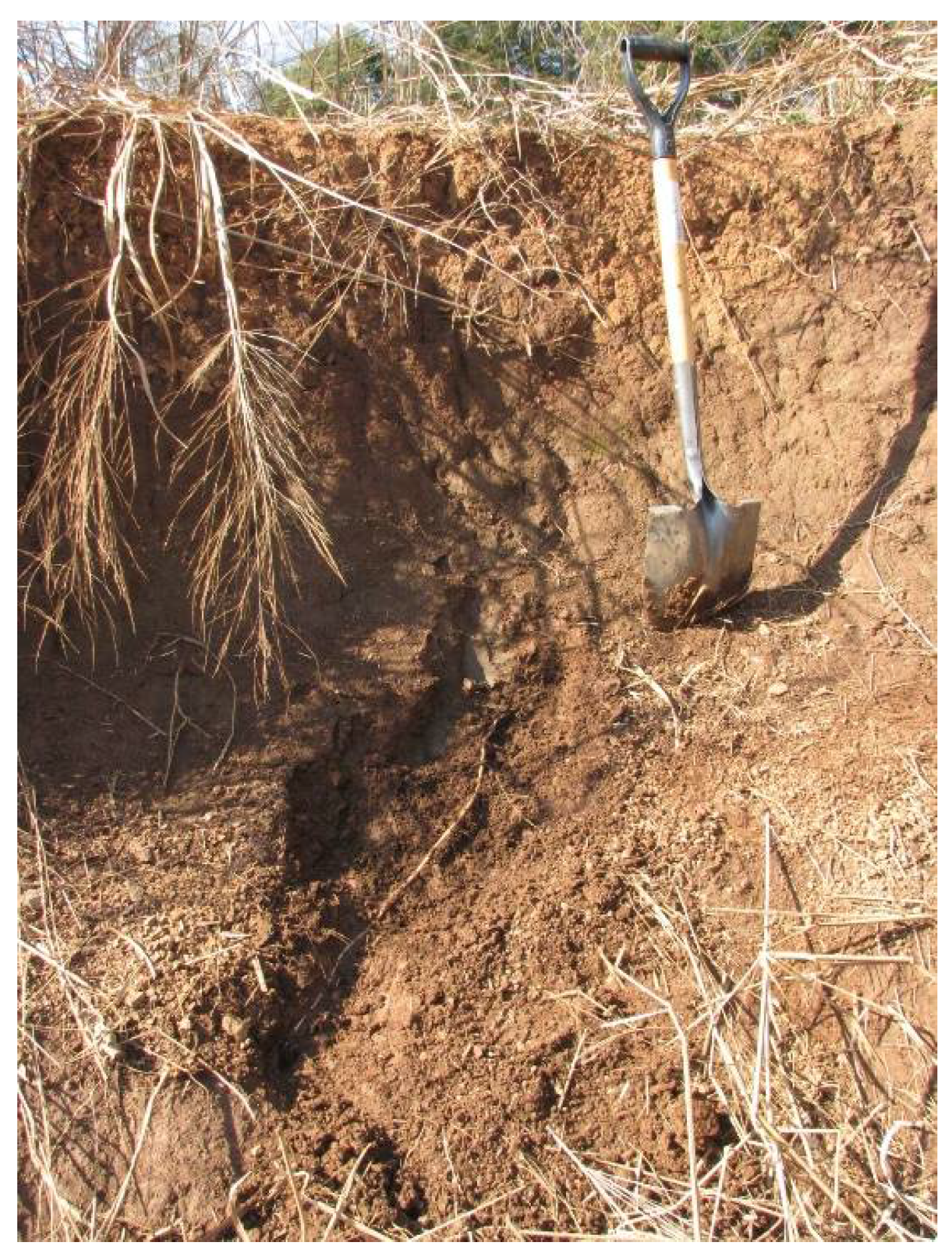

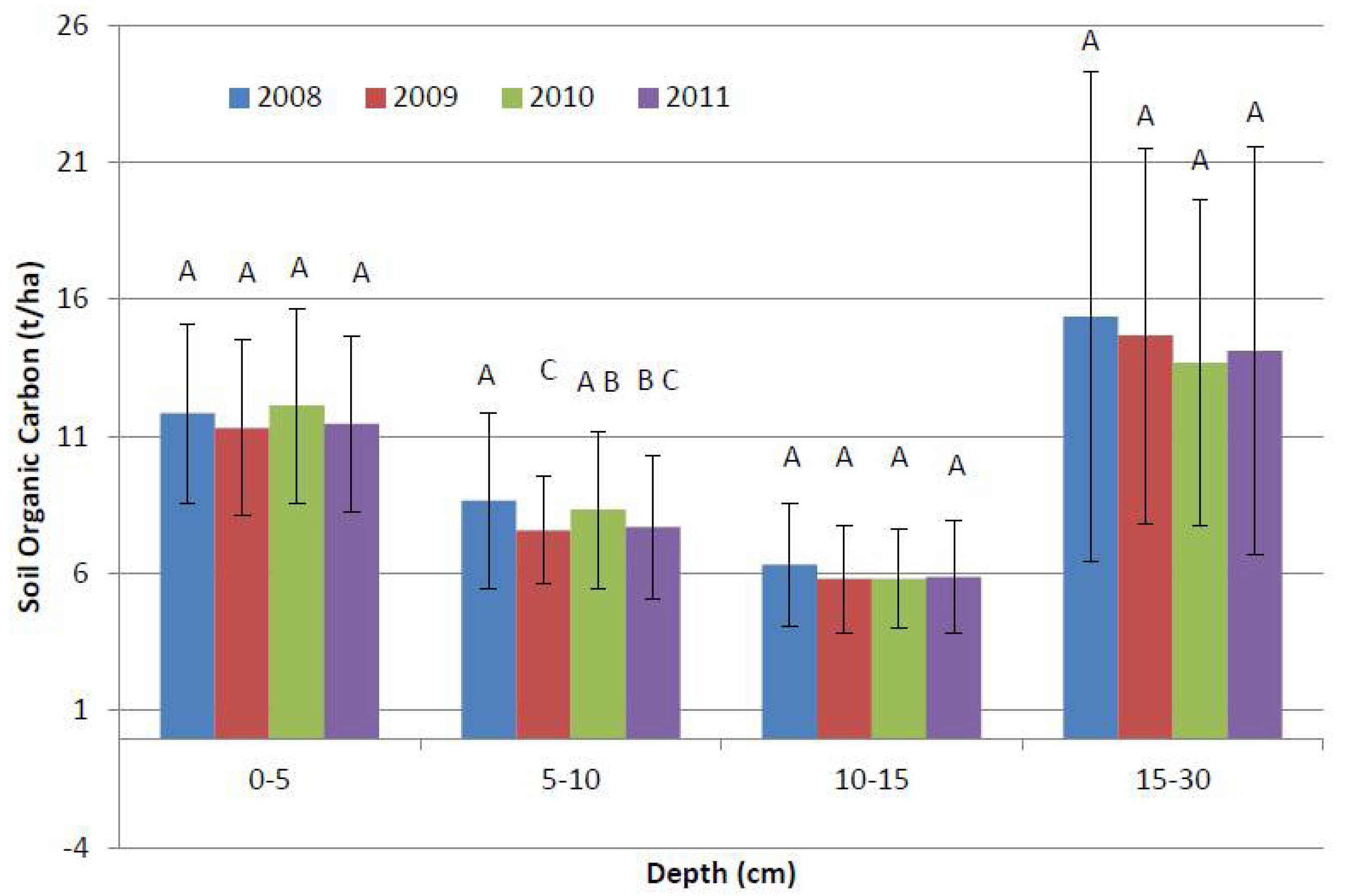

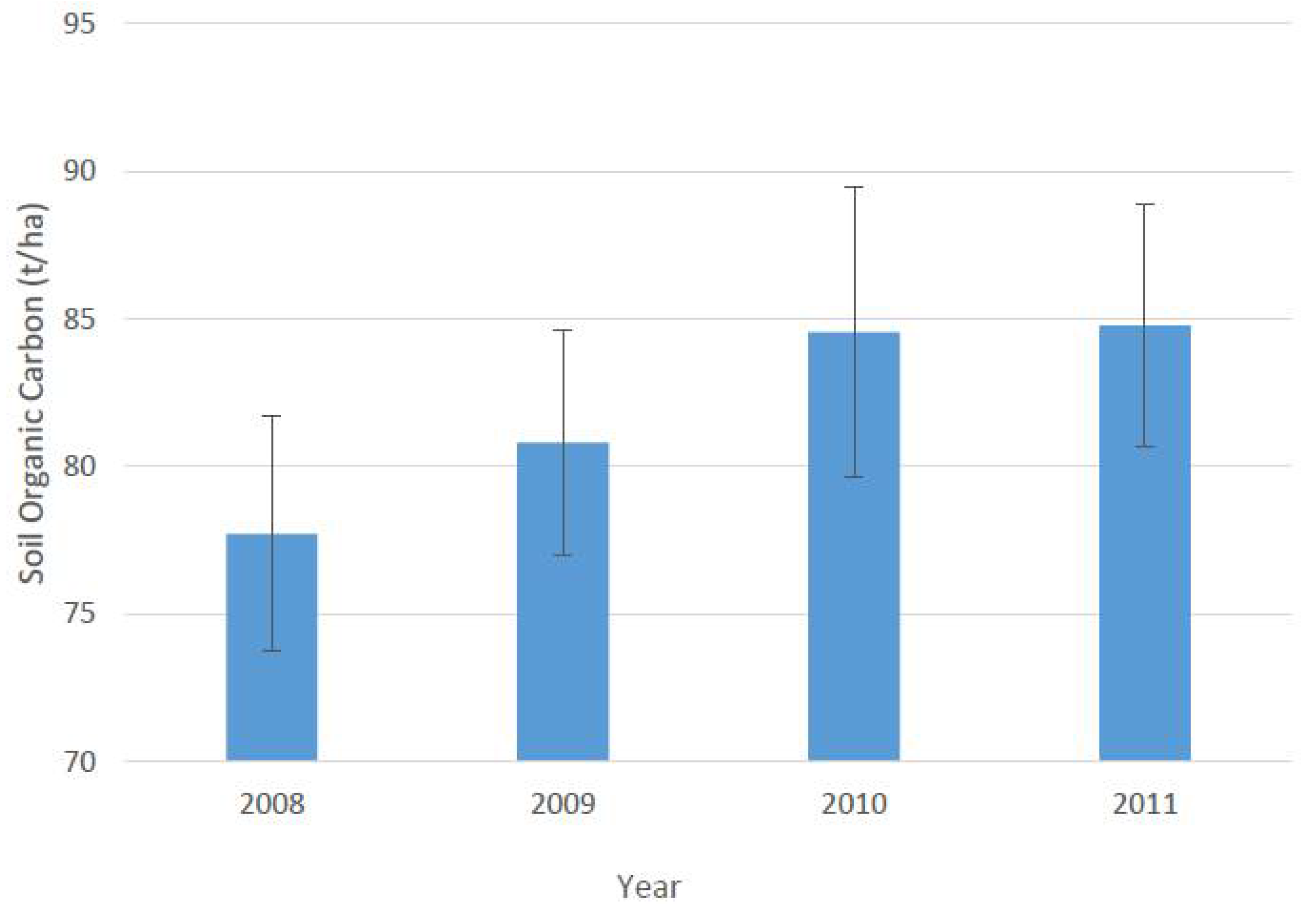
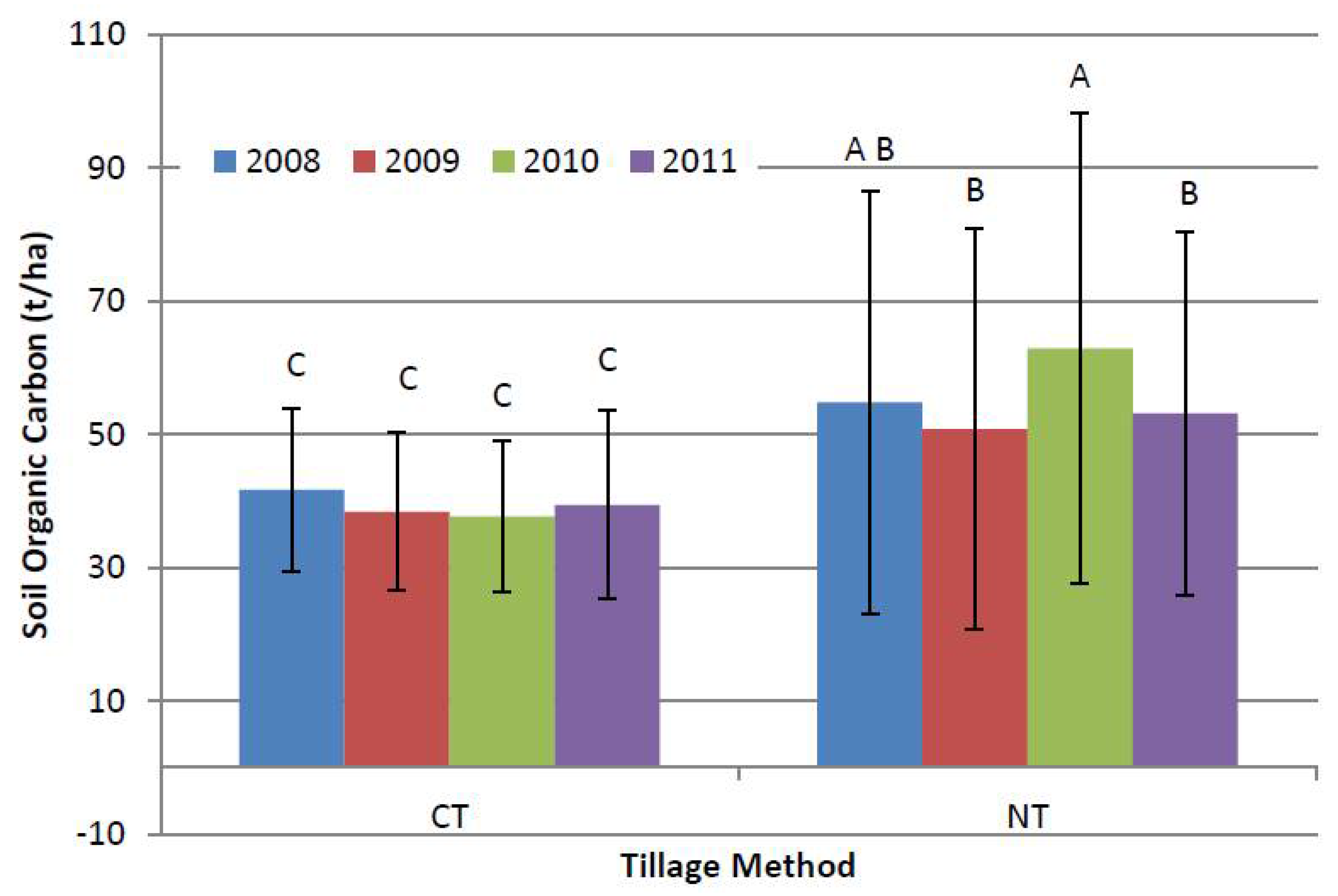
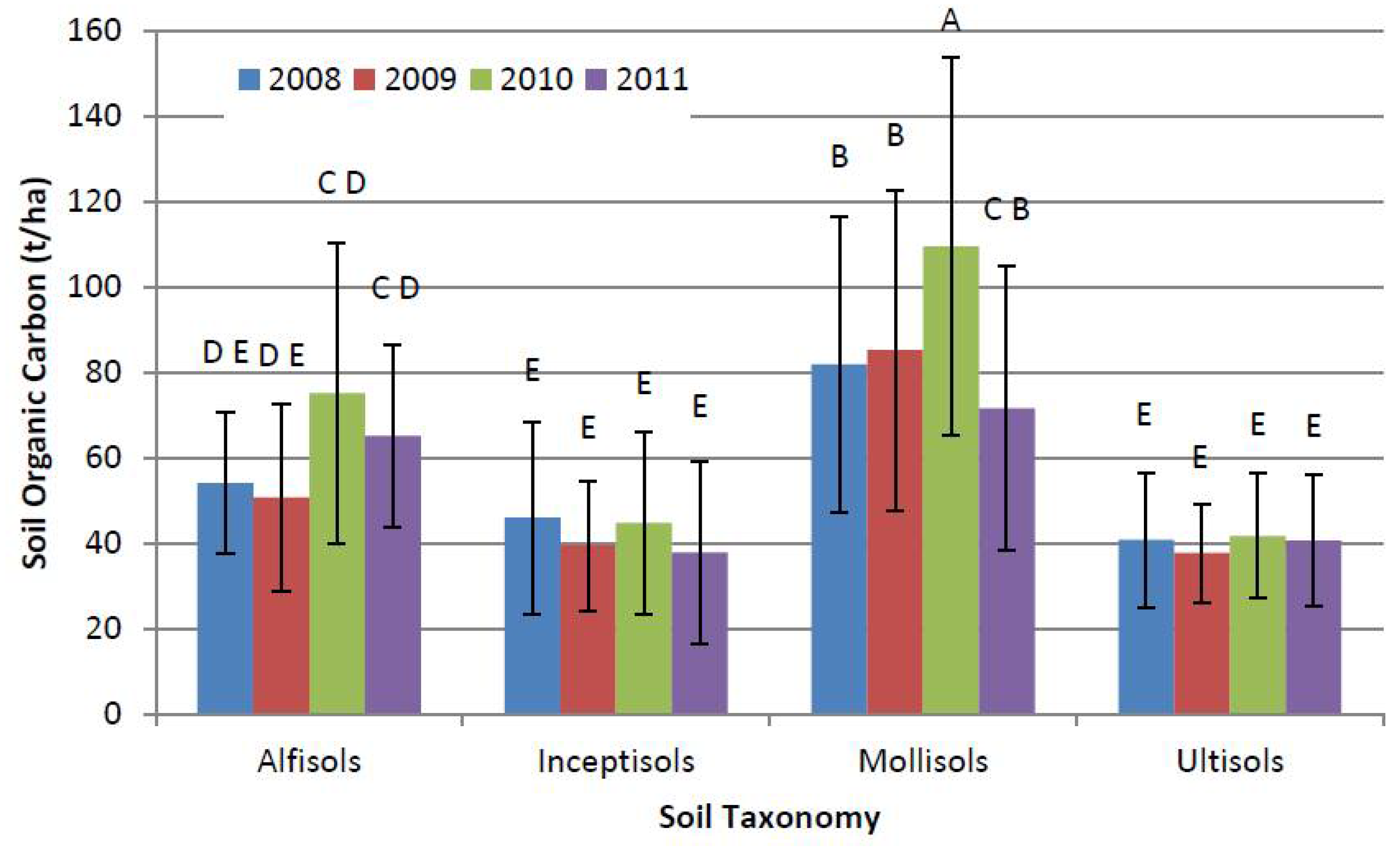
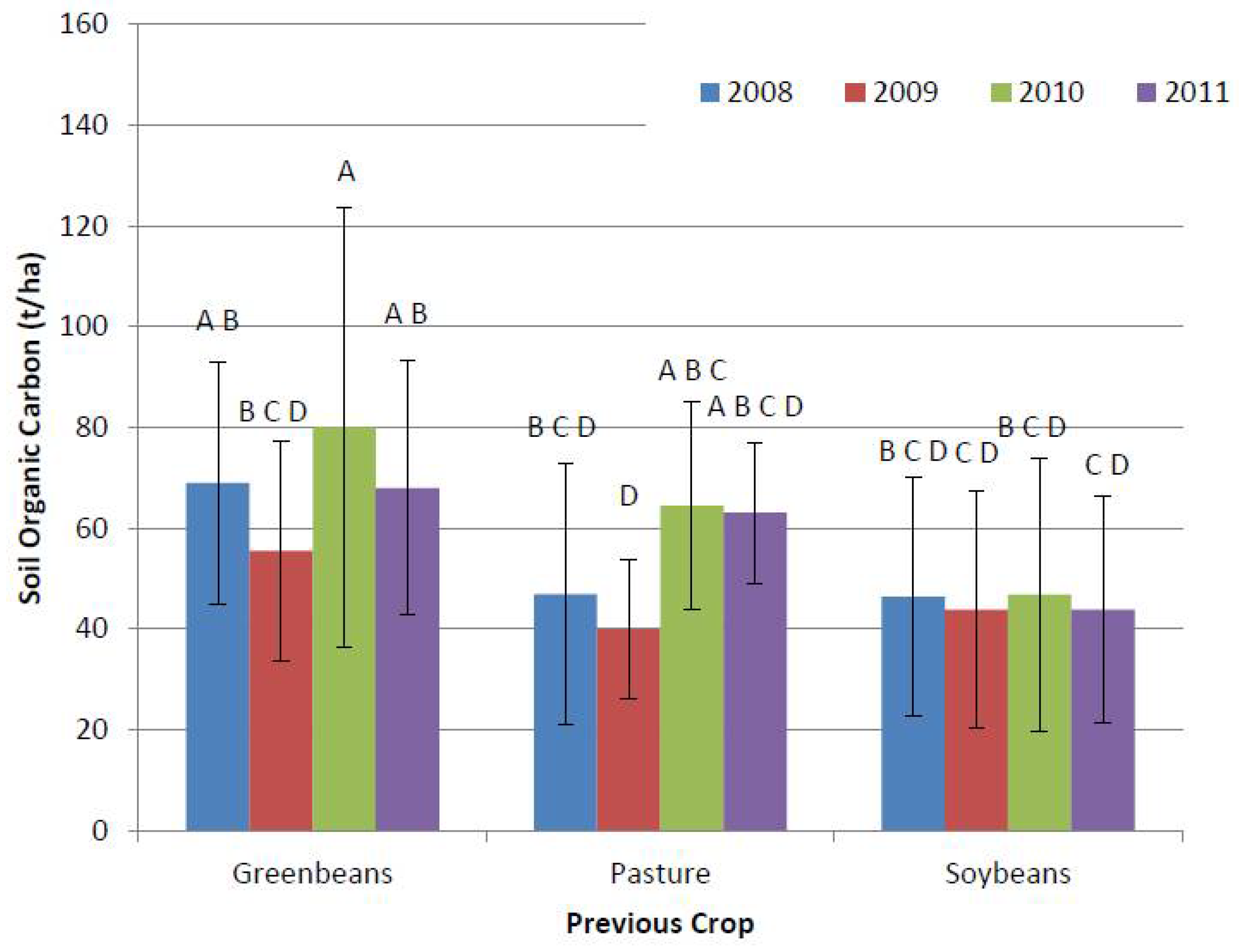


| Farm | County | Hectares | Previous Crop | Soil Taxonomy | Tillage a |
|---|---|---|---|---|---|
| A | Monroe | 54.7 | Soybeans | Mollisols | NT |
| B | Monroe | 27.9 | Soybeans | Ultisols | NT |
| C | Polk/McMinn/Bradley | 22.2 | Pasture | Ultisols | CT |
| D | McMinn | 31.4 | Soybeans | Inceptisols | CT |
| E | Blount/Loudon | 6.8 | Soybeans | Alfisols | NT |
| F | Rhea | 30.4 | Green beans | Alfisols/Inceptisols | NT |
| G | Loudon | 15.9 | Pasture | Ultisols | NT |
| Farm | Farm ID Number | 2008 Yield | 2009 Yield | 2010 Yield | 2011 Yield |
|---|---|---|---|---|---|
| t/ha | |||||
| A | 4 | 2.4 | 13.0 | 20.9 | 13.5 |
| B | 5 | 3.8 | 15.9 | 15.4 | 14.7 |
| C | 8 | 5.6 | 13.2 | 9.2 | 11.8 |
| D | 9 | 4.4 | 7.1 | 13.7 | 19.0 |
| E | 12 | 2.1 | 6.7 | 13.5 | 10.9 |
| F | 13 | 1.2 | 10.2 | 15.2 | 16.0 |
| G | 15 | 9.7 | 15.1 | 17.5 | 16.7 |
| Variable | Coefficient | t-Value |
|---|---|---|
| INTERCEPT | −2.29 | −0.20 |
| CT | 5.33 | 1.29 |
| Pasture | 26.34 *** | 4.41 |
| Green beans | 24.87 *** | 3.14 |
| Ultisols | −24.85 *** | −3.31 |
| Inceptisols | −42.95 *** | −5.29 |
| Mollisols | −36.78 *** | −3.97 |
| Yield | 2.83 * | 1.94 |
© 2018 by the authors. Licensee MDPI, Basel, Switzerland. This article is an open access article distributed under the terms and conditions of the Creative Commons Attribution (CC BY) license (http://creativecommons.org/licenses/by/4.0/).
Share and Cite
Toliver, D.K.; English, B.C.; Tyler, D.D.; Lee, J.; Menard, R.J.; Walton, J.C. Soil Organic Carbon Changes for Switchgrass Farms in East Tennessee, USA. Soil Syst. 2018, 2, 25. https://doi.org/10.3390/soilsystems2020025
Toliver DK, English BC, Tyler DD, Lee J, Menard RJ, Walton JC. Soil Organic Carbon Changes for Switchgrass Farms in East Tennessee, USA. Soil Systems. 2018; 2(2):25. https://doi.org/10.3390/soilsystems2020025
Chicago/Turabian StyleToliver, Dustin K., Burton C. English, Donald D. Tyler, Jaehoon Lee, R. Jamey Menard, and Jon C. Walton. 2018. "Soil Organic Carbon Changes for Switchgrass Farms in East Tennessee, USA" Soil Systems 2, no. 2: 25. https://doi.org/10.3390/soilsystems2020025




